The exam is over and we did a little survey in class. The results are below; 19 students participated. If you'd like to add another comment on what you see here
email me or leave a comment below this post.
There did seem to be one or two surveys that were irregular: The first ten questions all scored 1, the next three were 4s and 5s. Perhaps the instructions were misread?
Without any further ado, here are the results of our class's survey. Please share your thoughts by commenting (anonymously if you wish) below .....
Classroom EnvironmentThe questions in this section were ranked using this 5 point scale:
| Strongly Disagree | Disagree | Neutral | Agree | Strongly Agree |
| 1 | 2 | 3 | 4 | 5 |
The
bold numbers after each item are the average ratings given by the entire class.
1. The teacher was enthusiastic about teaching the course.
4.532. The teacher made students feel welcome in seeking help in/outside of class.
4.133. My interest in math has increased because of this course.
3.534. Students were encouraged to ask questions and were given meaningful answers.
4.215. The teacher enhanced the class through the use of humour.
4.376. Course materials were well understood and explained clearly by the teacher.
3.897. Graded materials fairly represented student understanding and effort.
3.538. The teacher showed a genuine interest in individual students.
3.769. I have learned something that I consider valuable.
3.3710. The teacher normally came to class well prepared.
4.47Overall Impression of the CourseThe questions in this section were ranked using this 5 point scale:
| Very Poor | Poor | Average | Good | Very Good |
| 1 | 2 | 3 | 4 | 5 |
1. Compared with other high school courses I have taken, I would say this course was:
4.052. Compared with other high school teachers I have had, I would say this teacher is:
4.473. As an overall rating, I would say this teacher is:
4.53Course Characteristics1. Course difficulty, compared to other high school courses:
Very Easy
0% | Easy
5.3% | Average
36.8% | Difficult
57.9% | Very Difficult
0% |
2. Course workload, compared to other high school courses:
Very Easy
0% | Easy
10.5% | Average
68.4% | Difficult
21.1% | Very Difficult
0% |
3. Hours per week required outside of class:
0 to 2
21.1% | 2 to 3
36.8% | 3 to 5
26.3% | 5 to 7
15.8% | over 7
0% |
4. Expected grade in the course
(n = 18):
F
5.6% | D
5.6% | C
50% | B
27.8% | A
11.1% |
Specific Feedback[
Ed. Note: Numbers in parentheses indicate the number of students, over 1, that gave the same answer.]
What was your best learning experience in this course?
Scribe posts (2)
Solving problems on the SMARTboard (5)
Group work (8)
This blog (5)
Daily slides on the blog (2)
Developing Expert Voices Project (2)
Pre-Tests
Personal Finance Unit (2)
Design & Measurement Unit
Trigonometry
Not using textbooks
Class flows well
A lot of attention paid to students specific needs
Communication
Learning
Hands-on learning
Enjoyed this class
Teacher was enthusiastic
Help provided |
What was your worst learning experience in this course?
None (3)
Not having a computer at home
Not having enough confidence to answer questions I knew were right
Scribes who missed important information
Blogging
Don't know
Not getting tests back quickly
Group work assignments
Not asking for help
Forgetting my calculator
Statistics Unit
Too much content in too little time
I don't like math
I didn't put enough effort into homework and tests (2) |
What changes would you suggest to improve the way this course is taught?
Pick people to answer questions more often
Classmates should be more encouraging to form study groups
None (3)
I love this class and the people in it (2)
Return tests quicker (2)
It's good
Tell better jokes
Use a textbook
Have take-home assignments
Timed group work assessments are stressfull
There was too much homework
Scribing was hard
More time for each unit
I wish Pi Day was every day
Nothing, excellent class
In-class games
Make blogging optional |
Additional Student Comments
Mr. K. I think you're an awesome teacher, you listen to each and every individual. I wouldn't change anything or want anything different as a student your teaching techniques are awesome and highly reasonable.
Mr. K. you are an inspiration.
It was a great semester and I'm glad to have been one of your students; no lie.
#1 teacher ... and well I've gone through more teachers than usual. |
It's interesting to compare the items that were considered both the worst and best learning experiences. Also, take a look at the list of worst learning experiences compared to suggestions for next year. Help me do a better job next year by commenting on what you see here ....
 We had our graduation exercises today. A gentle push into the world for all of you. I hope you're leaving with the keys to your future in your hand.
We had our graduation exercises today. A gentle push into the world for all of you. I hope you're leaving with the keys to your future in your hand.



 With The Knoch Snowflace
With The Knoch Snowflace
 After that we work on drawing the Fractor.... That is all of today, remember draw the Fractor as the homework !!
After that we work on drawing the Fractor.... That is all of today, remember draw the Fractor as the homework !!







.jpg)




 Question #1
Question #1




